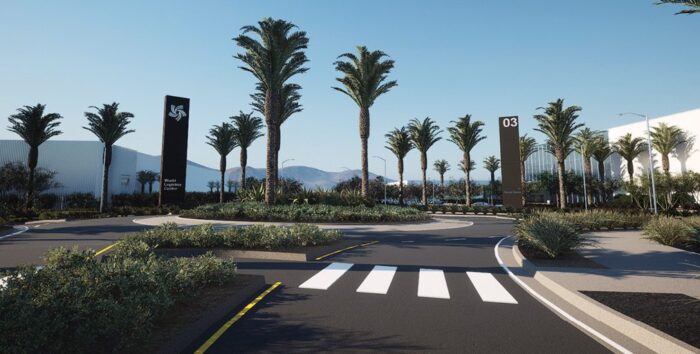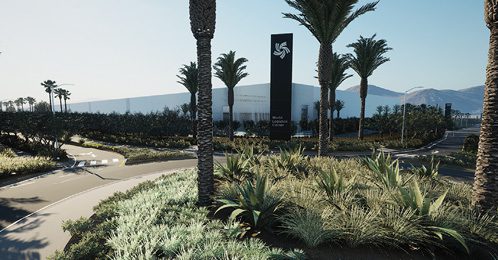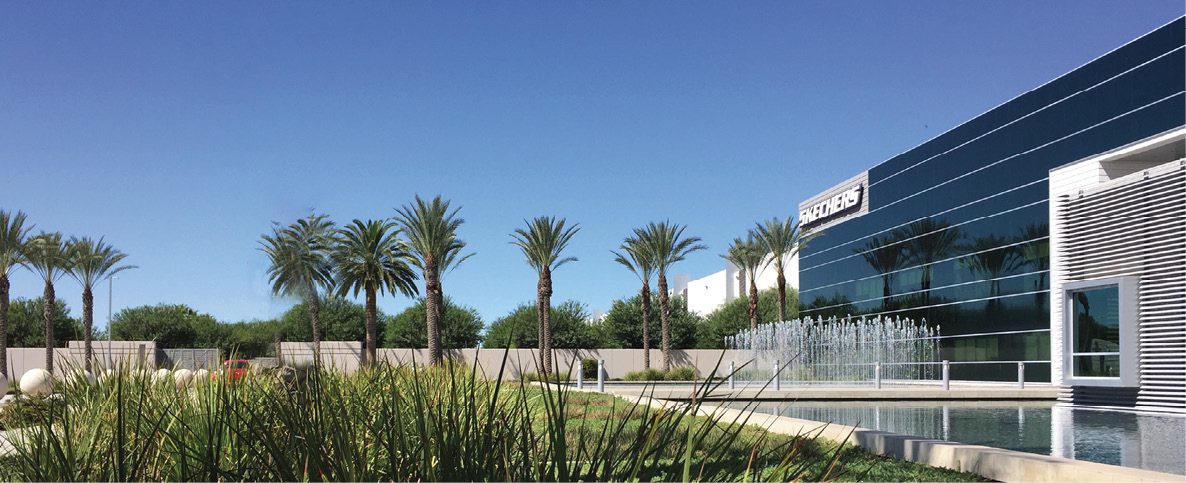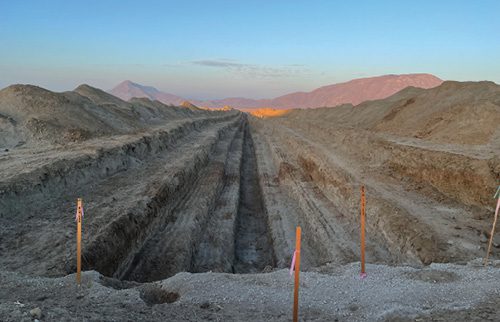World Logistics Center: Engineering Heavyweights Collaborate to Ease California’s Warehouse Space Demands

Artist’s renderings show the World Logistics Center, which is set to break ground in Moreno Valley, Calif., later in 2023. (Stantec/Highland Fairview)
The quest for warehouse space is more challenging than ever. Vacancy rates are at an all-time low in metropolitan areas across the United States, according to Prologis, a real estate investment trust headquartered in San Francisco that invests in logistics facilities. The situation is particularly dire in California for several reasons, including the meteoric rise in ecommerce and the fact that most consumer goods coming into the United States from Asia come into the West Coast—the ports of Los Angeles and Long Beach, in particular. Consumer-goods companies want to be close to these ports to get products out for distribution as quickly as possible.
The need to ease this chokepoint is driving an unprecedented effort to create the largest, most-efficient and most-advanced logistics center in North America. The World Logistics Center, a $25 billion project developed by Highland Fairview, will be constructed over seven years on a 4-square-mile site that will contain more than 40 million square feet of facilities, including walkable streets, cafes, restaurants, spaces for arts and culture, breweries, and public spaces. The project has 29 sites available, with the potential to link multiple buildings via skybridges to form corporate campuses.


Supply Chain Solutions
Located in Moreno Valley, Calif., the World Logistics Center’s site is in Southern California’s Golden Triangle, a region that encompasses Los Angeles, Orange and San Diego counties as well as the Inland Empire—the country’s largest manufacturing and logistics hub, with easy access to seaports and three of the busiest airports in the United States. More than 40 percent of goods coming into the country pass through the Golden Triangle. Housing multiple national brands and logistics providers, the World Logistics Center will be able to provide overnight delivery to 11 western states and three-day delivery to any destination in the continental United States.
The World Logistics Center will maximize supply chain efficiency by using supervisory control and data acquisition systems to integrate logistics providers for coordination. This strategy ensures the maximum number of trucks depart full by carrying shipments from multiple providers as needed. The end result will be increased shipping efficiency, better use of transportation resources and reduced carbon emissions.

Skechers already has two massive warehouses connected by a skybridge at the World Logistics Center’s site, and the company plans to build another. (Stantec/Highland Fairview)
Enabling Sustainability
First proposed in 2012 and approved by the Moreno Valley City Council in 2015, the World Logistics Center has been a controversial project. Residents and environmental groups were concerned the warehouse complex would increase traffic and air pollution as well as negatively affect local wildlife. In 2021, Highland Fairview reached a deal with several environmental groups that had opposed the project, agreeing to maximize onsite rooftop solar generation as well as provide electric vehicle chargers and achieve LEED-Silver certification for the core and shell of all the warehouse buildings, among other sustainable features. The developer is aiming for the center to be a carbon-neutral facility, which would make it the largest sustainable logistics cluster in North America.
Highland Fairview hired Stantec, a global leader in sustainable design and engineering, as the project’s prime consultant. Stantec’s project team includes 300 professionals in civil and electrical engineering, urban planning, and other disciplines. In addition, Michael Baker International is designing an interchange for site access, ENGEO is delivering geotechnical engineering services, and Dudek is providing environmental permitting.
“The scale of this iconic project and its focus on sustainability creates a unique opportunity to advance the development of sustainable construction and operational practices in industrial buildings,” says Dave Calder, global industrial sector leader for Stantec.
With more than 40 million square feet of rooftops, the center will have a vast capacity for solar-power integration. Stantec is examining the use of onsite battery storage and microgrids to increase energy resilience, with the expectation that the facility will not have to rely on the external power grid.


With about 8,000 linear feet of fault trench, the project is one of the largest fault-evaluation studies in the world. (ENGEO)
The center also will prioritize water conservation, a critical issue in California. According to Stantec, facility design is expected to result in a 70-percent reduction in water usage compared to the current general plan for the City of Moreno Valley. This will lead to a savings of 653 million gallons of water every year—enough water for 27,000 households. Drainage through the site will be treated before it’s discharged while paying careful attention to maintaining historic drainage patterns and protecting the downstream environment.
The World Logistics Center site also will tap into the latest mobility solutions. That applies to freight and passenger travel to and from the site as well as within the site. The facility has 1,080 electric vehicle charging stations integrated into its design. Chargers will be available for freight and logistics vehicles, employees and visitors.
Autonomous vehicle (AV) technology also is being explored for the site. Trucking is set to be one of the first industries to break through on AV technology, and the World Logistics Center will be ready to take a lead role in its integration. Highland Fairview is looking to acquire zero-emission semitrucks, and AV shuttles are being explored as a means of local travel within the development.
Site Challenges
Southern California is located in a seismically active area and is subject to ground shaking resulting from seismic activity on regional and local faults. Before issuing any building permits for the project site, the City of Moreno Valley required a site-specific, design-level geotechnical investigation that complied with all applicable state and local code requirements, including an analysis of the expected ground motions at the site from known active faults using accepted methodologies. The investigation also needed to determine structural design requirements as prescribed by the most-current version of the California Building Code, including applicable city amendments, to ensure structures can withstand ground accelerations from known active faults.
To develop a geotechnical baseline report, ENGEO performed a supplemental subsurface exploration, including a geologic fault study, to identify the presence of potential fault traces within the project limits and provide recommendations for developing the area at and near any confirmed fault locations. The company performed the fault exploration by excavating deep fault trenches, and its findings were corroborated by multiple third-party geologists. The surveyed locations were used to establish building setbacks and final design parameters for walls, foundations, foundation slabs, utilities, roadways, parking lots, sidewalks and other related improvements.
ENGEO recommended ways to minimize the amount of sub-excavation required to develop the site and proposed a system of ground-improvement methods to support the project’s building designs, which could be up to 80 feet tall. According to ENGEO’s CEO Uri Eliahu, the firm’s site investigations quantified different construction techniques for foundation preparation and slab support to handle the loads of the taller buildings.
In addition, the site needed additional exploration to locate pockets of infiltration to help meet flood-control and water-quality-treatment needs. The project’s design and engineering team is considering using deep dynamic compaction, along with traditional site-preparation methods, for ground improvement; drone technology to map grading efforts; and water-quality treatment technology and infiltration wells to convey treated stormwater into the subsurface aquifer.
ENGEO will use GIS technology from Esri to help track construction efforts as well as spatially display constructed appurtenances and testing data for future capital projects. The firm also developed a web-based GIS portal to visually display project information. ENGEO also used Settle3D software from Rocscience to predict static loading settlements, CLiq software from GeoLogismiki to evaluate liquefaction and dry-sand densification, and CPeT-IT software from GeoLogismiki to help identify potentially collapsible soil.
“We had to be nimble to support Highland Fairview’s requests, which required our lead engineering geologists to be onsite for multiple weeks to coordinate field-investigation efforts,” explains Eliahu. “We also had staff geologists and engineers onsite for months to complete the studies needed to support the design solutions currently being finalized by the project’s lead civil engineer.”
According to Eliahu, project optimization doesn’t only involve advanced software, laboratory testing or new innovative engineering approaches. Focusing on how studies and recommendations can help the client and design team achieve their goals can reduce overall project costs, shorten design timelines and limit project team stress. On a project of this scale, optimizing little things can result in big savings.
“For example, if we can save a couple inches of aggregate base in the project’s roadway design, it could save the client millions of dollars,” says Eliahu. “If we can reduce the amount of concrete or reinforcing steel in the foundations, it could again save millions of dollars.”
In the spirit of this approach, ENGEO is working with ground-improvement contractors to optimize earthwork costs as well as looking into cement/lime treatment or geogrid reinforcement to reduce roadway sections. ENGEO also performed settlement analysis of a proposed roadway and its effect on existing infrastructure to allow it to be protected in place.

The project’s geotechnical engineering team is using a specialized drone to develop surveying
and mapping applications. (ENGEO)
Widespread Benefits
According to Stantec, more than 33,000 jobs will be created through the World Logistics Center’s construction and ongoing operations, with an estimated $22 million in property and sales taxes generated annually for schools and community colleges. Overall, the center is expected to generate nearly $3 billion in economic benefit for the region. Construction is set to begin in late 2023, and the project will add 6 million square feet per year until it’s completed in 2030. 
About John Hughes
John R. Hughes is a freelance writer specializing in issues related to urban planning and sustainable development. He can be reached at [email protected].


